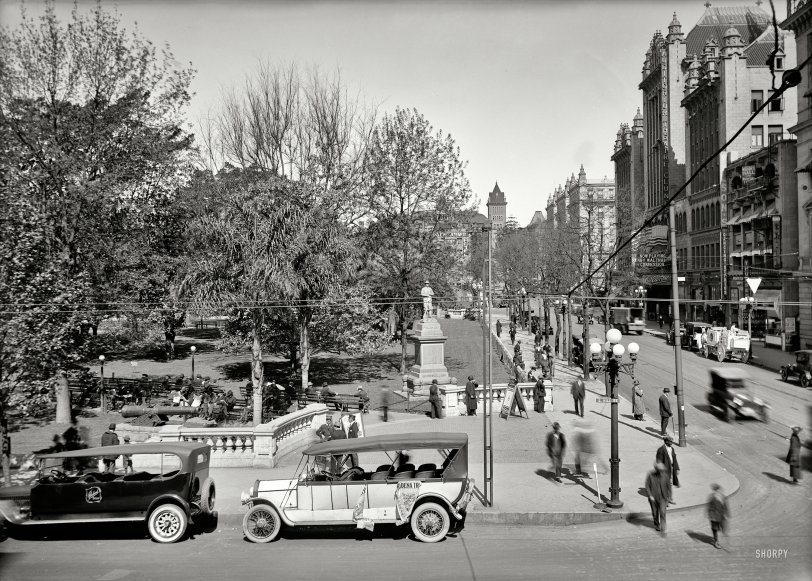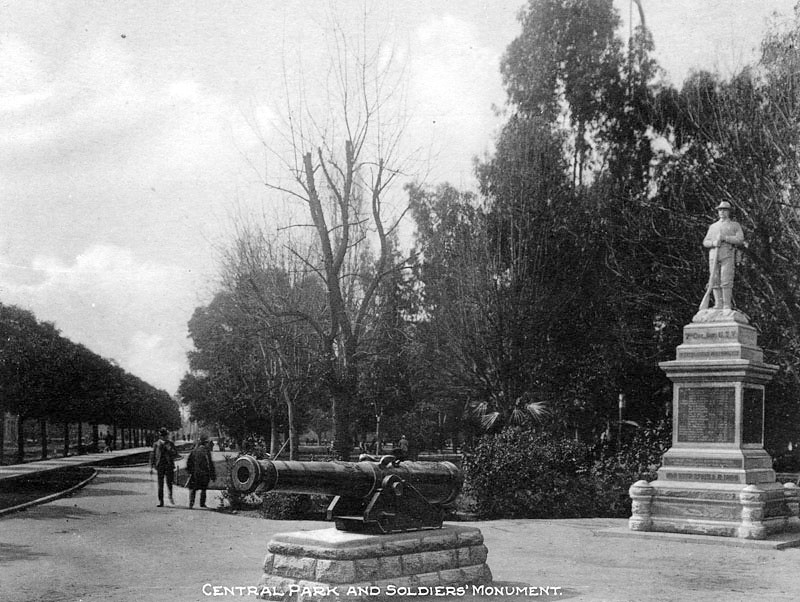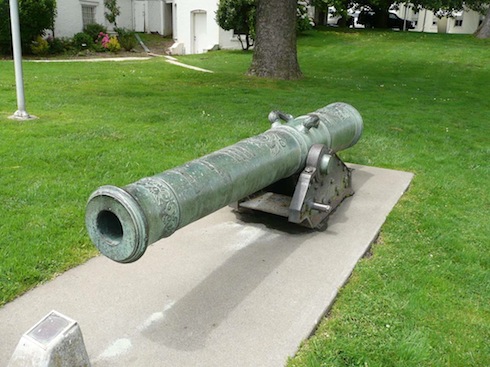


Framed or unframed, desk size to sofa size, printed by us in Arizona and Alabama since 2007. Explore now.
Shorpy is funded by you. Patreon contributors get an ad-free experience.
Learn more.

- Details, Details
- What's that building to the left of the tower?
- Coal Barges
- Bromo-Seltzer
- Inner harbor
- The Basin
- What a headache!
- Giant stepladder?
- Baldwin 62303
- Baldwin VO-1000
- Cold
- No expense spared
- Tough Guys
- Lost in Toyland
- And without gloves
- If I were a blindfolded time traveler
- Smoke Consumer Also Cooks
- Oh that stove!
- Possibly still there?
- What?!?
- $100 Reward
- Freeze Frame
- Texas Flyer wanted
- Just a Year Too Soon
- WWII -- Replacing men with women at the railroad crossing.
- Yes, Icing
- You kids drive me nuts!
- NOT An Easy Job
- I wonder
- Just add window boxes
Print Emporium
Confession: 1920

Los Angeles circa 1920. "Fifth Street and Spanish-American War monument in Pershing Square." Now playing at Clune's Auditorium Theatre: Henry Walthall in "Confession." Also note the "Pasadena Trip" touring car. View full size.
Cannon history
Thanks Tobacconist! All we knew of the history of the Presidio gun was its inscription, the original records apparently lost during the 1906 fires. You've filled a huge gap in our knowledge of the bronze cannon.
The speech reported in the newspaper by Gen. Shafter describing his acquisition of the twin weapons will be added the museum records about the Presidio gun.
Tip of the hat to Dave and all the folks at Shorpy for helping solve another mystery.
Who's first?
From the website cinimatreasures, we learn of Clune’s Auditorium (originally called Temple Auditorium, and designed by Charles Frederick Whittlesey) that “…at the time of its completion, Temple Auditorium was the largest reinforced concrete structure in the world.” The building opened in 1906.
Numerous resources will confirm that Albert Kahn, often called “the architect of Detroit,” developed the concept of reinforced concrete construction, and that the Packard plant (designed by Kahn and opened in 1907) was the first manifestation of the method. I wondered how the Packard plant could claim the ”first” status, when Temple opened in 1906.
I believe the solution to the seeming contradiction lies in the phrase “at the time of its completion,” regarding Temple. Given the magnitude of the Packard project (which dwarfed Temple), it’s almost a certainty that blueprints were drawn and work actually commenced well in advance of the Temple initiative. Therefore, the Packard plant can rightfully claim the “first” status.
Unless demolition occurred very recently, the Packard plant shell is still standing, as are many other Kahn designs.
Traveling cannon
According to a 1941 guidebook to Los Angeles:
Nearby is a bronze cannon made in 1751 for the navy of Louis XV of France; it was captured in 1898 at Santiago, Cuba, by the American corps commanded by Major General William R. Shafter, who presented it to the city.
General Shafter made the presentation on Thanksgiving Day, 1899 and the cannon was placed in the northeast corner of (the then named) Central Park at 5th and Hill Streets, and was displayed like this:

The later reconfiguring of the sidewalks caused the cannon to be moved to the position seen in the 1920 picture.
After World War II, when the underground parking garage was built (and the statue was shortened as seen here), the cannon was moved to Travel Town—a railroad oriented museum that also housed other, non-train displays. In 1987 the museum decided to focus solely on railroad artifacts and deaccessioned all other items to appropriate museums. The Shafter cannon wound up at the Los Angeles Maritime Museum, where it can be seen lounging on the observation deck.
A reporter's story of the cannon and his search for it is told in three parts here, here, and here.
Big time show biz
The "Auditorium Theatre Clunes" on the mid-distant right with its 2,700 seats was the biggest movie palace west of New York City and, upon its completion in 1906, the largest reinforced concrete structure in the world. Much more about this leading early 20th Century show business establishment here: http://cinematreasures.org/theaters/13960
Cannon's fate?
Do any Shorpy readers know the fate of the cannon at lower left? There's a virtual twin on display in the Presidio of San Francisco. (Below)
According to the engraving on the Presidio gun, it was captured in Cuba during the Spanish-American War and donated to the City of San Francisco by the Native Sons of the Golden West.
Was a twin gun presented to the City of Angels?

Served When Called
When I looked at the monument to the 7th California Soldiers, I thought it was like most other war monuments and it listed the Soldiers who had died during the war.
Not a single one of the Soldiers listed on the plaque died in battle. All 20 men listed on the memorial tablet died of illness while in San Francisco between May 6, 1898 and December 12, 1898.
Since the 7th Infantry Regiment was raised from Los Angeles the memorial was placed there. The monument was dedicated on Memorial Day 1900 and it still exists, in slightly modified form, in Pershing Square. It is the oldest piece of public artwork in Los Angeles. After the dedication, the name of a 21st Soldier who died of illness was added on the side of the monument.
The full story of how the monument came to be is here.
Because of the weight of the monument, when a parking garage was put underneath Pershing Park, the statue height was reduced.
Who's the genius
who said "What this square needs is fewer trees, and an enormous concrete staircase." Public spaces of the past are almost always more appealing than contemporary ones. Seems you can spot a bad architect by their need to reinvent the wheel.
Cars, Curbs, Recruiting, & Trampling
The black car appears to be a 1916 or 1917 Packard with a coachbuilt charabanc body on a stretched chassis. The sign on the side looks like "Packard De Classe," which may be the name of the business.
The white car I have not been able to identify yet, but the seats in the passenger compartment are angled towards the center of the vehicle. The Pasadena Trip poster on the side almost looks like it could be rolled up like a window shade for storage.
Although curbs normally are not that interesting, note how deep the one is where the two cars are parked. Perhaps a remnant from the days of carriages, the deeper curb makes it easier to get into a vehicle. As you get closer to the corner, the curb becomes shallower making it easier for pedestrians to cross the street.
There is a classic Army recruiting poster behind the white car along with possibly a U.S. Marines recruiting poster next to it which is facing away from the camera.
Apparently the grass around the cannon and monument is sacred and no one is to be trampling over it. There is fencing around most of the grass and possibly a sign stating this as well. The sign is out of focus so I can't confirm what it says.
A Bit of a Stretch
Two modified extra long touring phaetons! Now I know where the idea for stretch limos came from.
+92
An uninviting concrete wasteland awaits.
Edit: I failed to mention that on the other side of the Square, across Olive St, sits the fabulous and historic Biltmore Hotel, definitely something that is on the must-see list if you visit L.A.
























On Shorpy:
Today’s Top 5